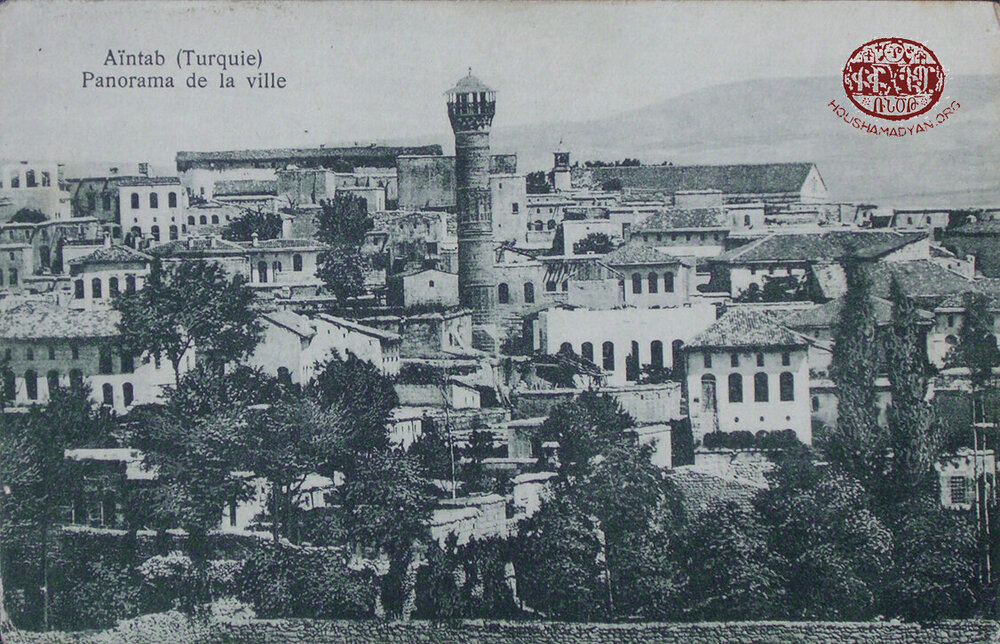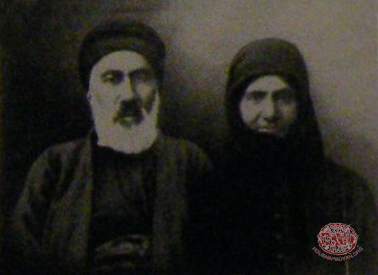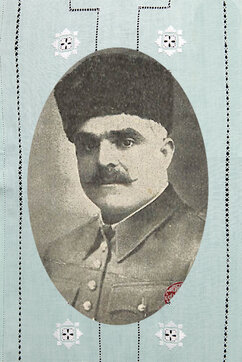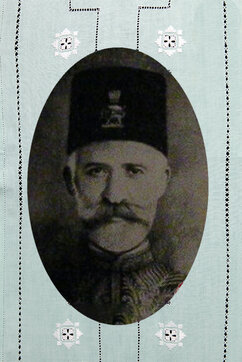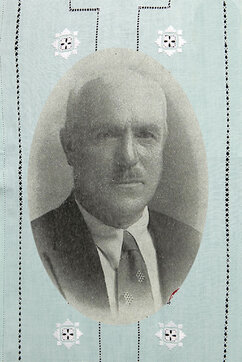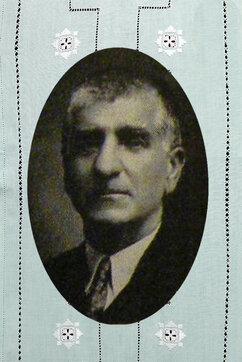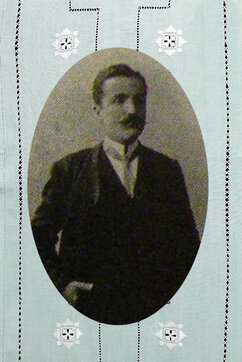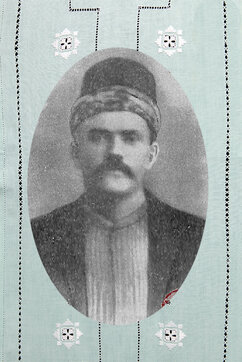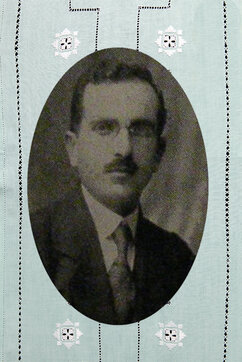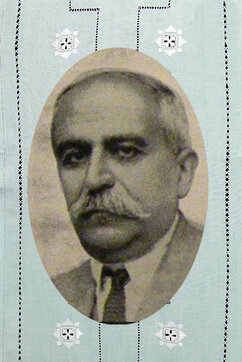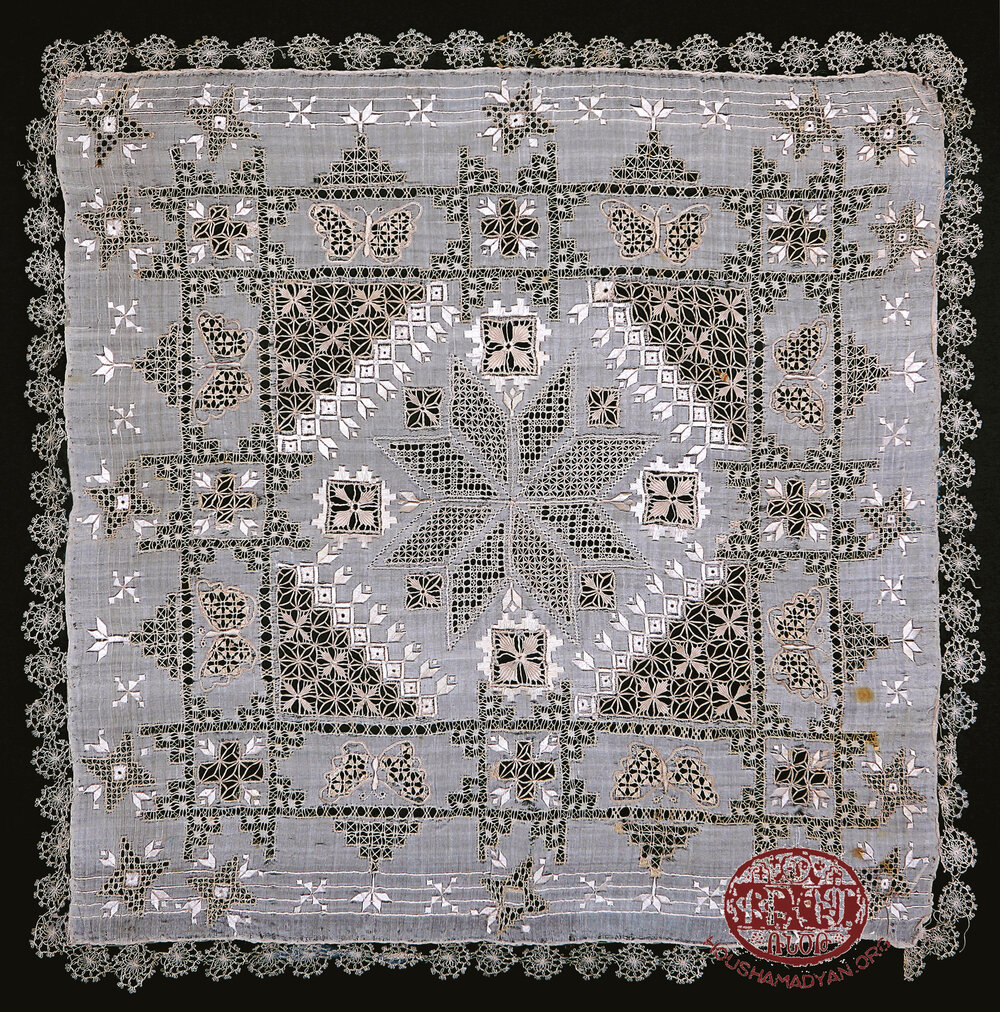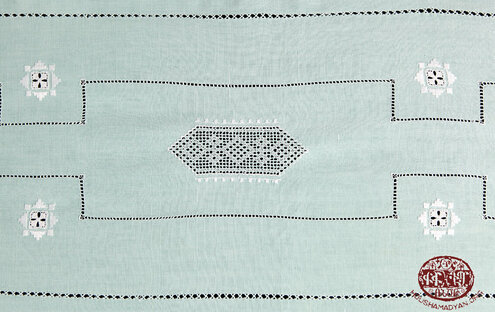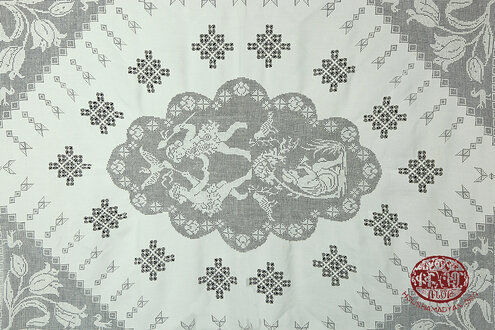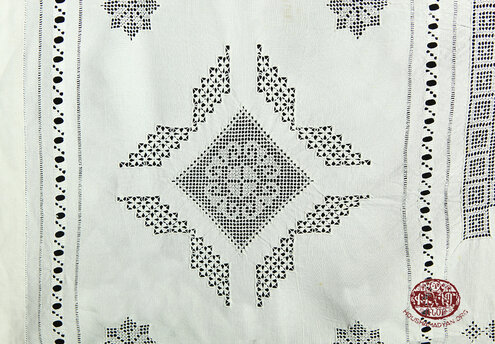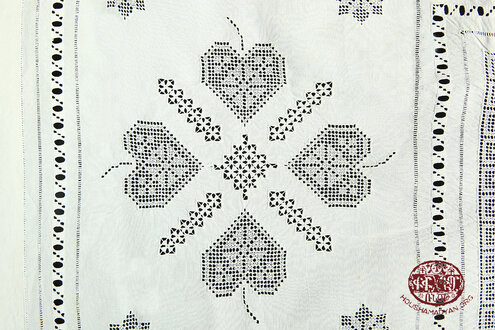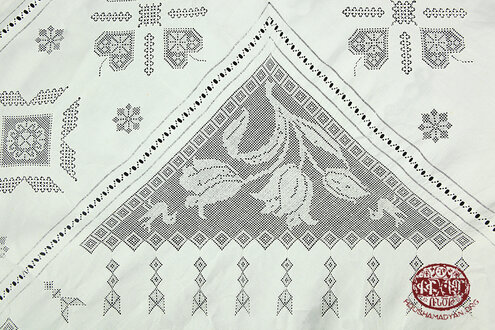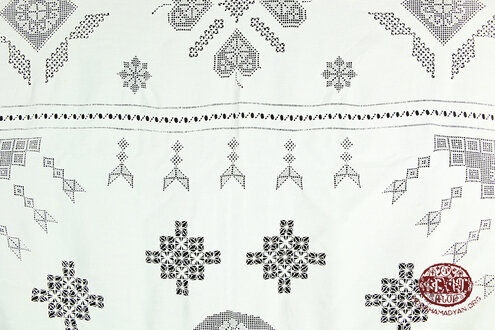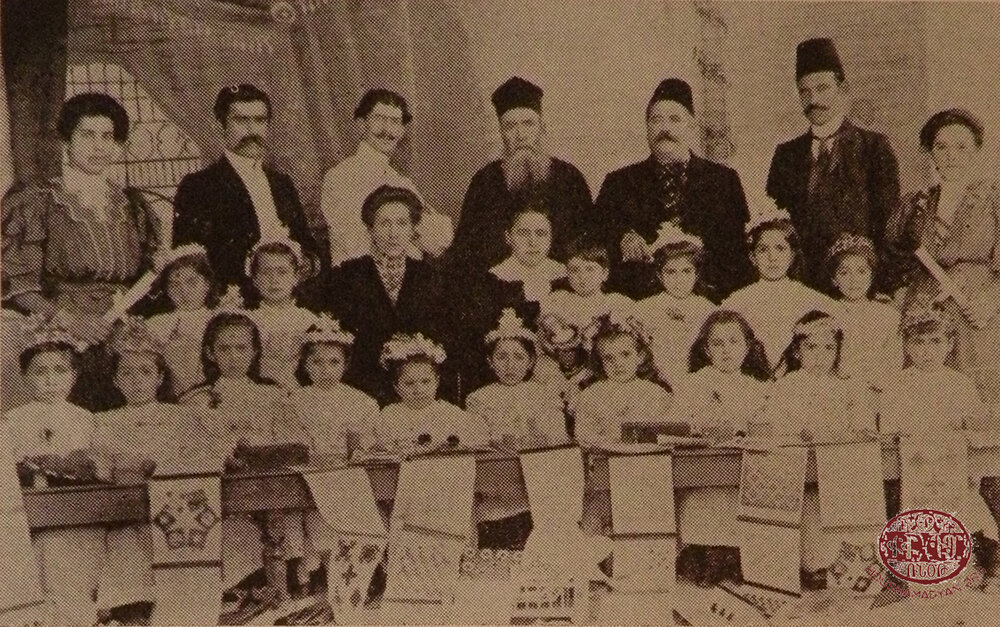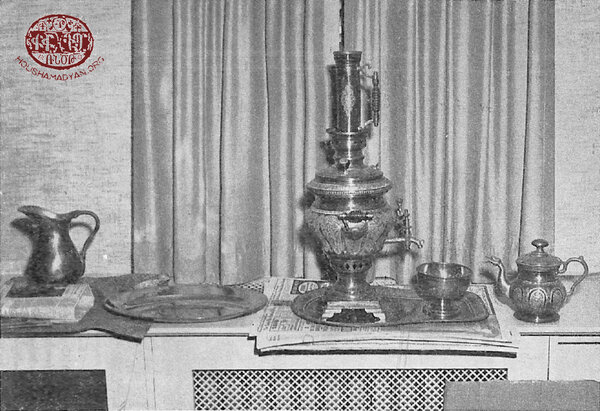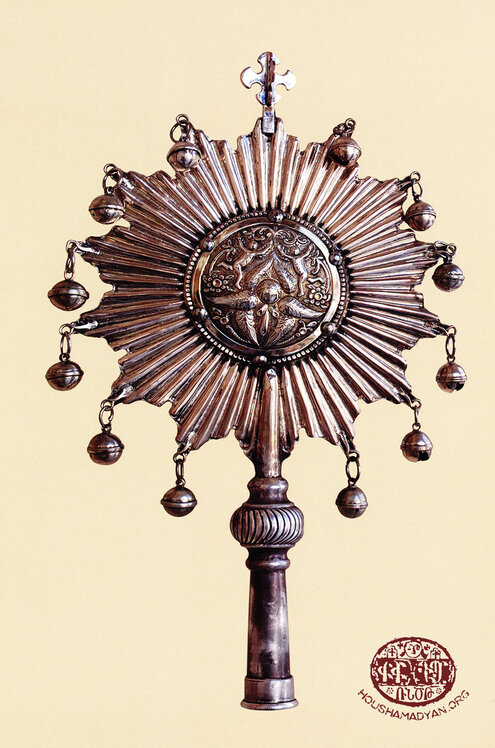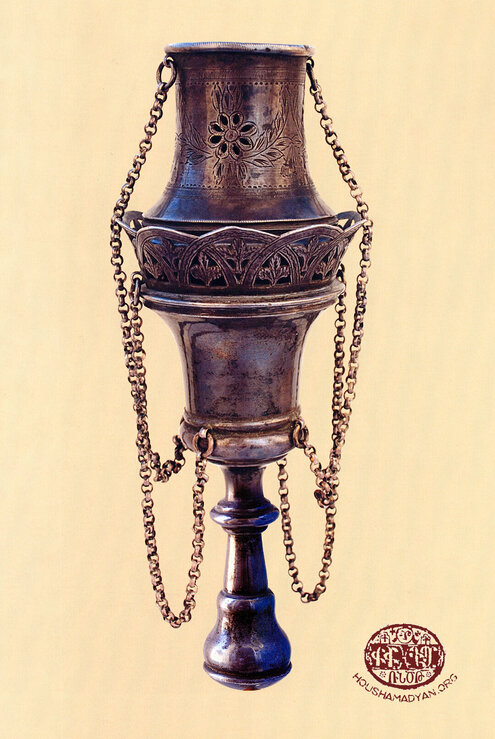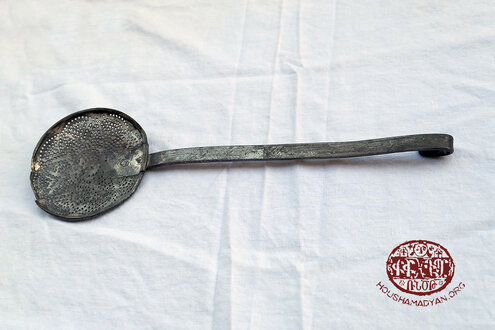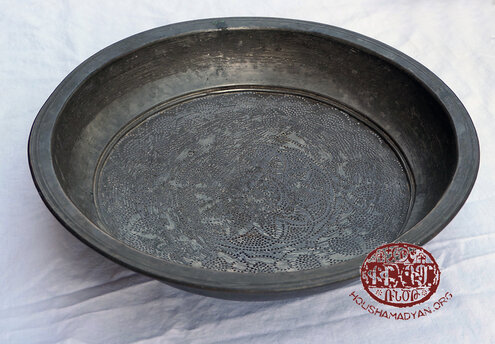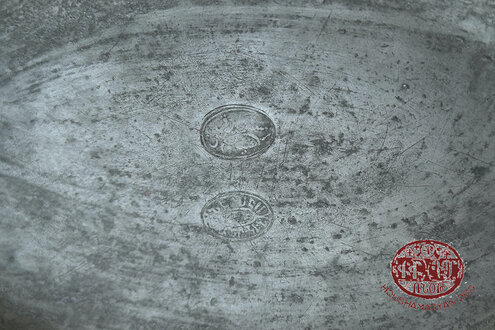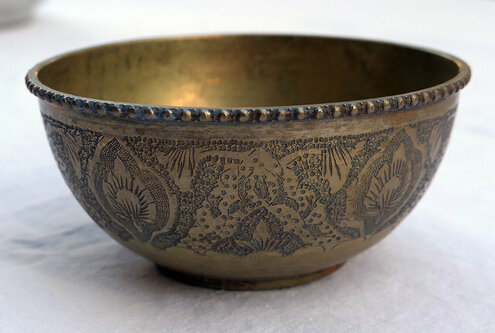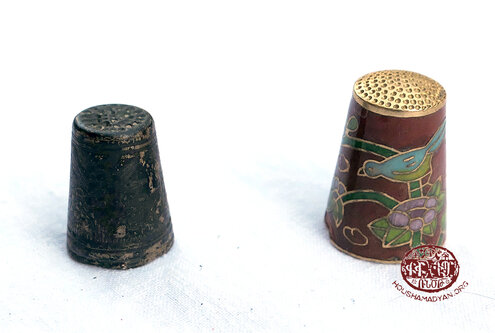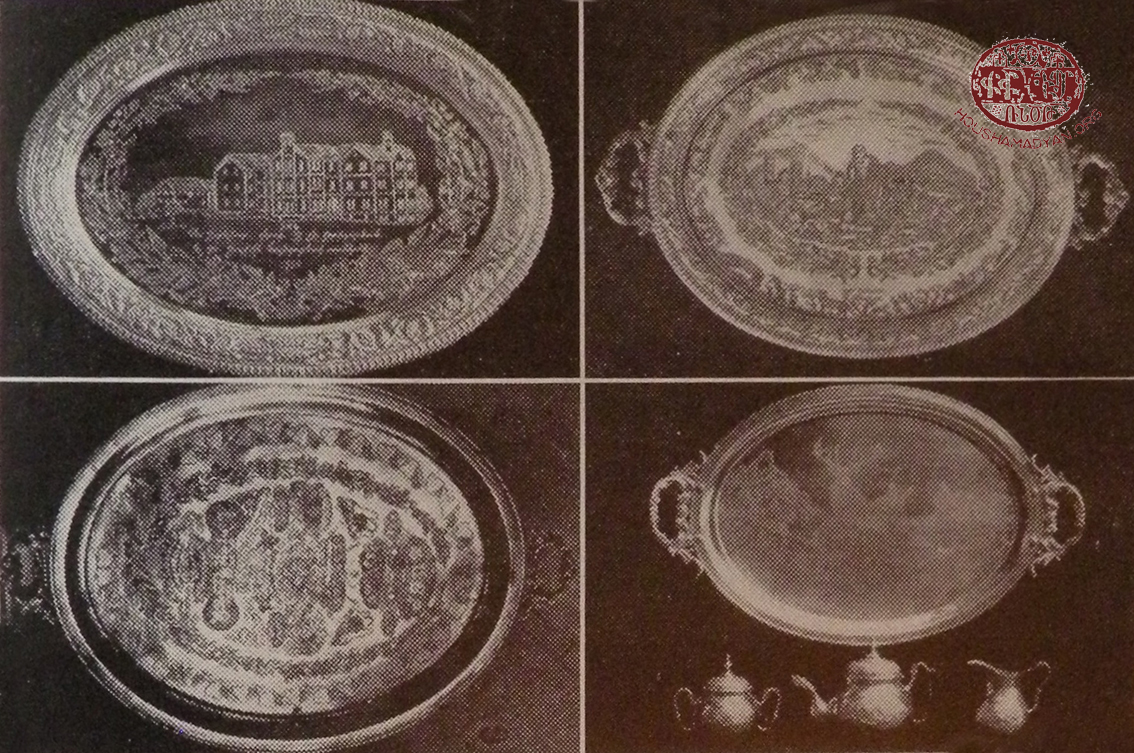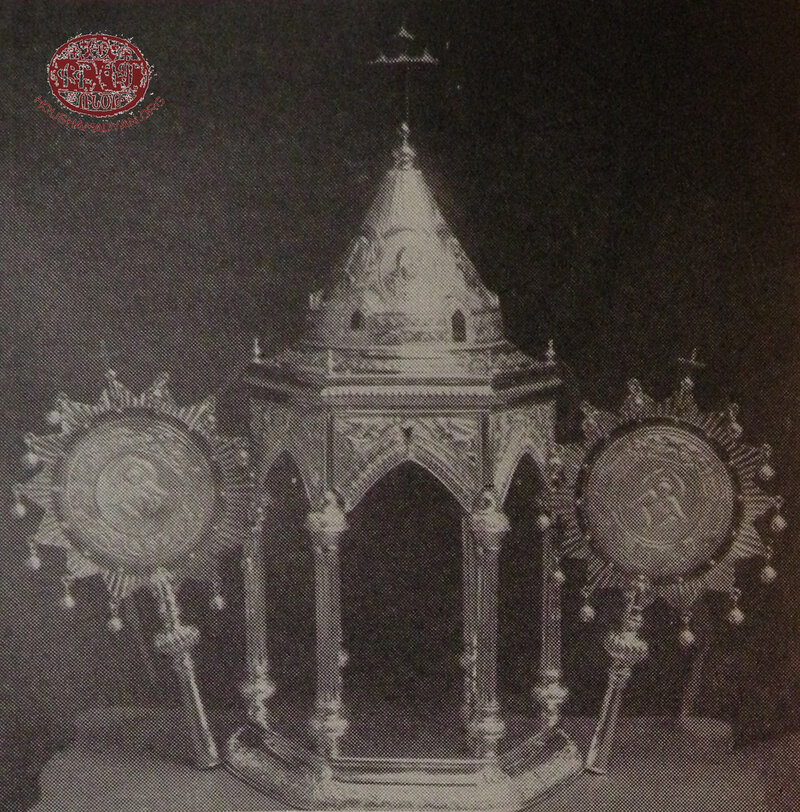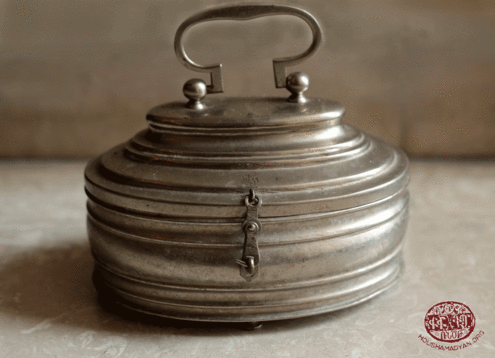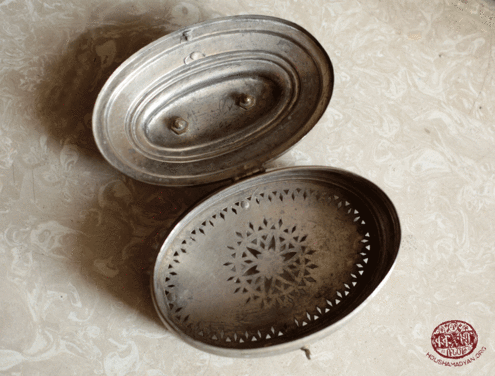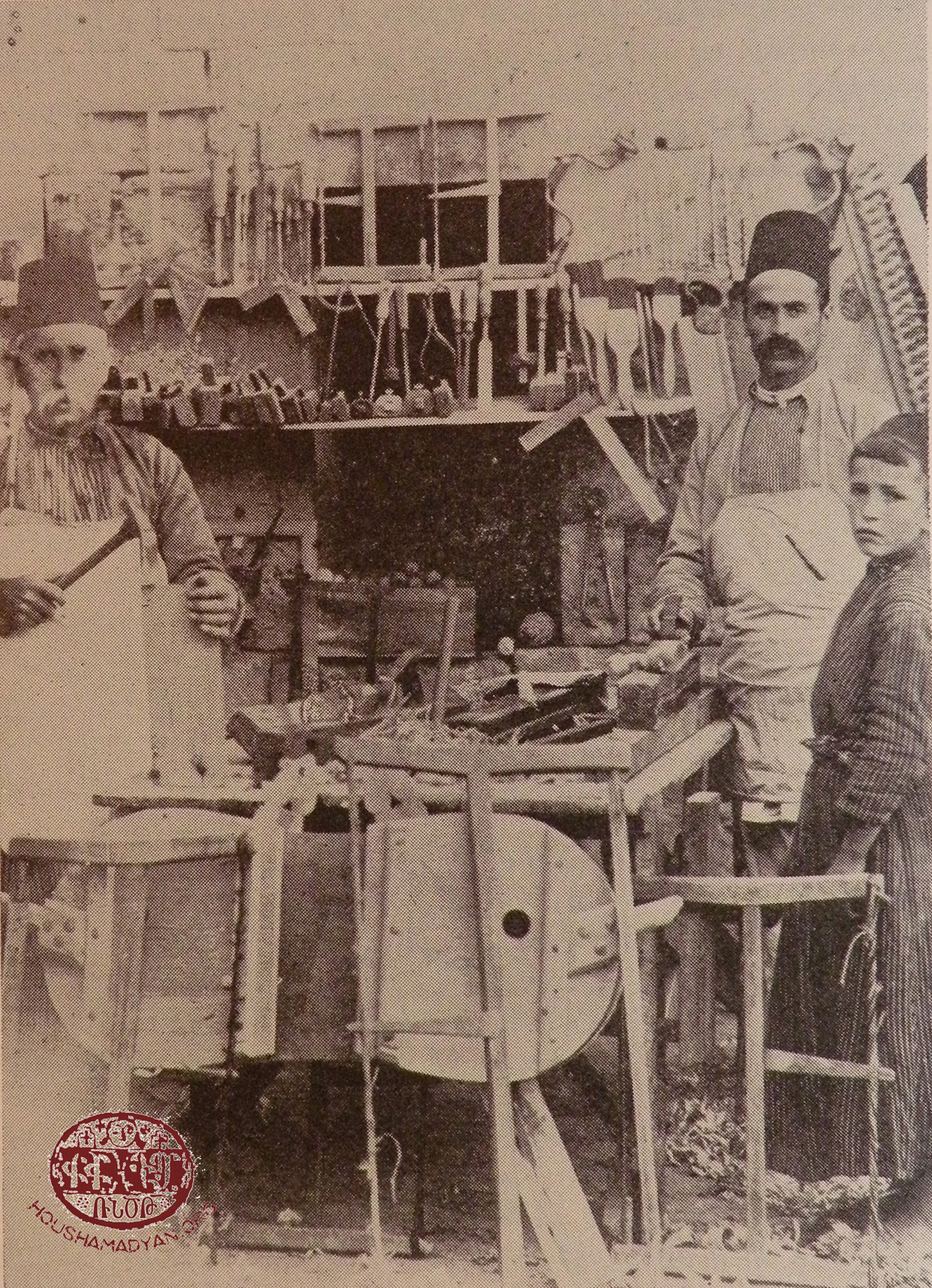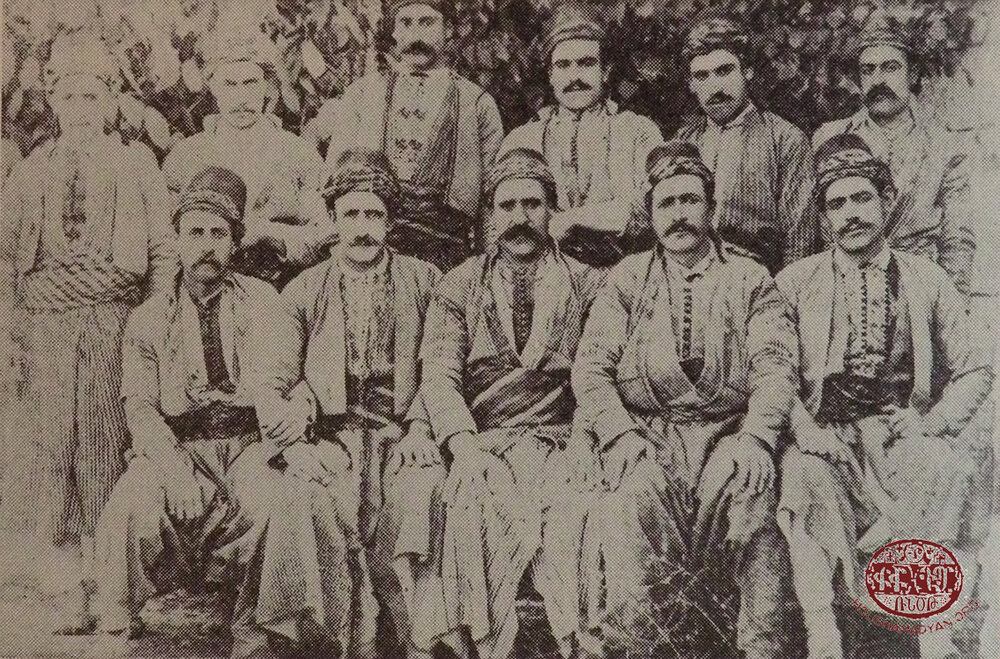Ayntab – Trades
Author: Ani Voskanyan, 01/06/2023 (Last modified: 01/06/2023) - Translator: Simon Beugekian

In the late 19th and early 20th centuries, Ayntab gradually became an economically stable and advanced city, which was a decisive factor in the development of local crafts and trades. Ayntab’s economy centered around the manufacturing of manisa and other textiles, soapmaking, shoemaking, winemaking, copper smithing, jewelry, embroidery, various types of confectionaries (bastil, soudjouk, bekmez), etc. [1] When listing Ayntab products, Krikor Koudoulian specifically mentions high-quality manisa and seg (cordovan leather), shoes and related items, and copperwares. Other popular Ayntab products included arak and oil. Occupations that had recently experienced a period of growth included weaving, soapmaking, and lacemaking. [2] It was noted that three-fourths of the city’s artisans were Armenian. [3] Via the port of Alexandretta, Ayntab had a direct link to the markets of Smyrna, Beirut, and Constantinople. Products exported in large quantities from the city included aladja fabric, leather, dried fruits and nuts [4], goat hair, tanning tools, etc. [5]

Leathermaking/Tanning
In the early 20th century, leathermaking and the production of manisa/manusa fabric retained their positions as the preeminent occupations of the people of Ayntab. About 3/8 of the population was engaged in these trades. [6] According to contemporary press reports, leathermaking/tanning was the second most-practiced occupation in the city, surpassed only by manisa manufacturing. [7] A total of 160 to 170 master plied their trade in Ayntab. The locally produced sakhtiyan (dyed leather) was of almost unrivaled quality. In 1908, one okha of Ayntab yellow leather had a value of 32 to 36 kurus, and red leather 42 to 45 kurus. Only a small portion of the locally manufactured leather was earmarked for the local shoemakers. Much of it was exported to Aleppo, Egypt, and elsewhere. [8]
Until 1870, leathermaking in Ayntab was the exclusive preserve of Armenians. In later years, members of other ethnic groups began entering the profession. The city was even home to a special leathermakers’ quarter, called Tabakkhane. Customarily, leathermaking was practiced by residents who lived north of the Fort of Ayntab. Approximately 35 master craftsmen were involved in the trade, and the number of workers reached 10,000. Each business, presumably, consisted of a master leathermaker and four to five workers. There were workers who cleaned untreated hide, workers who processed hide into leather, workers who polished the processed leather, etc. Generally speaking, the quality of life of these workers was above average, but only the income of leather merchants and master tanners, who represented only five percent of those involved in the trade, was sufficient to secure prosperity. [9]
It was believed that the leathermaking trade had been introduced into Ayntab, in the 1830s, by Vanus oghlou Haroutyun, of the Vanusian family, who had immigrated from Persia to Diyarbakir. Notably, the very type of leather that Vanus oghlou Haroutyun had perfected had the highest local demand. Among the well-known Armenian leathermakers and tanners of Ayntab were the Vanusian, Kasardjian, Srabionian, Panoyan, Adanalian, and the Duzdabanian families, as well as many families with the surname Tabakian, who had chosen this surname after adopting their profession. [10]
Hagopdjan Yakoubian, a prominent local merchant, was engaged in the leather trade, as well as the trade of coffee and sugar. His company’s office was located in Millet Khan. [11]
By 1915, leathermaking reached its apogee in Ayntab. The city’s tanners could produce European-style leather, for both the top and the soles of shoes. Until 1910, the leather dyes used in Ayntab were locally manufactured, while other raw materials were imported. Ayntab products were in high demand, and were exported to various cities across Cilicia, neighboring provinces, Egypt, and even as far afield as Sudan and India. [12] Yellow leather produced in Ayntab was exported in large quantities to Egypt and Sudan. [13]

Cobblery/Shoemaking
The establishment of this profession in Ayntab can be traced back to 1860. The city was home to a total of 40 cobblery/shoemaking workshops, each employing five to ten workers. These workers’ wages were average, and sometimes slightly higher. [14]

Textile Weaving/Manufacturing
The manufacturing of textiles, with its many branches, was an ancient and well-established trade in Ayntab. The city’s textile workers would specialize in weaving wool, cotton, or hair. Hair was used to make sacks and tents. Some workers made gaba, while others made mashla. Gaba weavers were generally Armenian. Approximately 60 families relied on this trade for their income. [15]
Garabed Karghayan (spelled Kargayan in some sources), after graduating from the parochial Nersesian School, entered the field of textile manufacturing. In a short time, he became an important member of the guild of master manisa manufacturers. He established his own trading house in the Iki Kapoulou Khan. The Kargayan Trading House also established chapters in Kharpert and Siverek. In Ayntab, his company was the first to mechanize the process of textile production by importing machinery from England. [16] Garabed Kargayan’s business was inherited by his son, Noubar Kargayan; and son-in-law, Hrant Barsoumian. But these two moved the company to Aleppo and Alexandria (Egypt), where they settled down during and after the massacres and deportations of 1915. In these cities, they also began producing dbadzo (printed) textiles. [17]
Among the families engaged in the trade of textiles, cloth, and dbadzo textiles were the Keordjemian (later Karamanougian) and Bazarbashian families. The Kouzougian and Barsoumian trading houses specialized in the trade of “yazma and chember” printed textiles. [18] Kevork Kouzougian, a native of Ayntab, alongside his brothers, introduced the craft of “basmadji and yazmaadji” into the city, which involved the printing of patterns and images onto textiles. Kouzougian, thanks to his own artistic talents and frequent travels, was able to create unique patterns; and having become an expert in the art of dyeing cloth, began producing exquisite works. He gradually developed his enterprise into a family business, which soon began creating jobs for other families. Kouzougian later opened chapters in various other cities and achieved great success. [19]
In the 1890s, weavers in Ayntab began making cotton socks, with about five to six looms dedicated to this purpose. After 1895, the people of Ayntab began manufacturing toiletry items, which, for the time, were only sufficient to meet local demand. [20] About ten looms produced bath towels, rags, and other similar items. The master weavers involved in this craft were all Armenian. [21]


Rug Making
By the mid-1800s, Ayntab had enough weavers and looms producing kilims (rugs) to meet local demand. In the early 20th century, the number of looms dedicated to this profession grew gradually, reaching 150. [22] According to other figures, a total of 200 looms in Ayntab, operated by 1,500 weavers, were dedicated to the production of rugs, belts, scarves, and towels. [23] Kilims were woven with local and European wool, with a mixture of wool and thread, and, when requested, only thread. Most of the city’s master rugmakers were Armenian, while the weavers were both Armenian and Turkish. Rugs were exported to Aleppo and further south, to Arab countries, as well as to Adana, Smyrna, Constantinople, and elsewhere. [24] Sources mention Avedik Guleserian [25], who operated a booth that sold rugs and clothing in the city’s market. [26]
Rugs were never produced in Ayntab in large numbers. Among the notable families involved in the trade were the Ouzounians. [27]

Belt Making
Belt making was introduced into Ayntab by migrants from Gurun, who began practicing this trade in the city in 1895. The city’s beltmakers produced speckled, Persian-style belts that were in high demand. The craftsmen were mostly Armenian, and they operated about 100 belt-making machines. With each passing year, the industry grew and developed further. The Apanian, Gedigian, and Mertakhanian trading houses were well-known beltmakers. [28] The Yaghsuzian family was known for specifically producing Gurun-style belts, which were in high demand particularly after 1908. These belts were sold both in Ayntab and the surrounding area. [29]

Tailoring
Tailoring was one of the most ancient trades practiced in Ayntab. In earlier years, the city’s tailors produced clothing of the traditional style, as well as attire made from high-quality fabric and sewn with rolled thread. They began producing European-style clothing after 1890. Initially, ten tailors operated in the city, each employing three to five workers. Among the well-known master tailors of Ayntab were Rakubian, Matosian, Boshgezenian, Bulbulian Terzi Mihran, and others. The number of local tailors who sold traditional clothing was initially high, at 30, but soon fell to 15, each employing two to three workers. Among the well-known local tailoring establishments were the Mesirian, Hadidian, Chekichdjian, and Der Sarkisian trading houses, among others. [30]


Embroidery
Valuable information regarding the practice of embroidery in Ayntab has been preserved in two books about the life of Vartouhi Seferian-Kaymakamyan, one by Professor Alexan Bezdjian, and another by Arousyag and Ferdinand Kaymakanian, who had settled down in New York. Vartouhi was born in Ayntab in 1835. She was one of the few literate women of the city. Prior to the establishment of girls’ schools, she provided home-based education to her daughters, teaching them sewing and embroidery. [31] As H. Tokmakdjian asserts, the above-mentioned books indicate that she also taught embroidery to other girls at her home in the 1840s. [32]
Notably, the Hayganoushian School, founded in 1877, raised funds by holding a year-end embroidery lottery. Arshalouys Aladjadjian-Nashalian, a previous graduate, taught embroidery, alongside other subjects, at the school from 1900 to 1907. [33]
Examples of Ayntab embroidery. Photographer: Hratch Tokatlian.
The embroidery curriculum of the Hayganoushian School is prime evidence of the importance and preeminence of embroidery in the city. Embroidery lessons to the pupils were provided in the following manner:
- - First year: Embroidery; introduction to khardj; eight class hours.
- - Second year: Embroidery, additional khardj lessons; introduction to lace and Ayntab nakush; eight class hours.
- - Third year: Embroidery; continuation of previous years’ lessons with more advanced activities; introduction to the broderi, konavle, and Ayntab nakush styles; eight class hours.
- - Fourth year: Embroidery on velvet and muslin; working with silk and beads; broderi, etc.; eight class hours.
- - Fifth year: Embroidery; additional lessons on working with delicate silk; eight class hours.
It must be noted that the class hours devoted to embroidery exceeded the hours devoted to any other subject at the school. No other subject was taught for eight class hours per week. [34]
Ayntab embroidery includes three completely distinct types of embroidery:
- a) Simple needlework on cloth, gari tsevov (“sewing style”).
- b) Oya, which Armenian women in the countryside would embroider with thick thread, without any cloth.
- c) Tel gdrel (cutting thread) or tel kashel (pulling thread), which involved cutting some of the threads of asou (wool) and filling the gaps with delicate embroidery. [35]
Gari Tsevov was the simplest type, as Armenian women had decorated their aprons with this type of embroidery for many decades, and thus had some experience in it. This type of embroidery only required thread (of cotton or silk) and was usually used to decorate collars or the fringes of pillowcases. In contrast, tel kashel required a high level of expertise and experience and was not easy to master. [36]
Embroidery became a viable source of income in Ayntab after the Hamidian massacres. The death of a large number of men forced many women to join the workforce in order to make a living. According to Eliza Sachaklian, the first women in Ayntab to attempt monetizing embroidery were her aunt (father’s sister), Khachkhatoun Gemirdjian; and her mother, Trvanda Der Melkonian. These two women produced superior examples of embroidery, which they sold to secure their income. [37]
Fanny Shepherd, an American missionary who settled down in Ayntab in the second half of the 19th century, greatly contributed to the advancement and growth of embroidery in the city. After many years of hard work and investments, by 1906-1907, Shepherd’s embroidery business could barely keep up with local demand. By then, more than 2,500 female embroiderers worked for the business. Shepherd had hired a female manager, responsible for hiring the workers, correcting their mistakes, and paying their wages. Another employee acted as the secretary and designer. The latter’s job was to design the patterns for the embroiderers, keep the accounts, and make sketches. [38] According to Krikor Bogharian, Shepherd’s trusted artist and secretary was Hovagim Bakkalian. The collaboration between the two greatly contributed to the rising popularity of the style of embroidery known as Ayntab nakhsh or nakush (“Ayntab work”). [39]
Fanny Shepherd also opened an embroidery/needlework school in her home, into which she accepted the daughters of the neediest of her workers. The school had an enrollment of 12 girls between the ages of 9 and 11. They were taught embroidery, reading, and writing. For each graduating girl, the school admitted another. The embroidery that the students produced, known as “Ayntab embroidery” to this day, successfully competed with foreign products, and was sold on the basis of “one hundred percent” profit. The school received orders from America, England, France, Germany, Egypt, and elsewhere. [40]
Contemporary press reports confirm that embroidery was a relatively lucrative industry in Ayntab. These reports note that the main foreign market for Ayntab embroidery was America, but that it was also exported to England and other European countries. A total of 300 Ottoman pounds’ worth of product was sold per week, 200 of which covered the workers’ wages. [41]
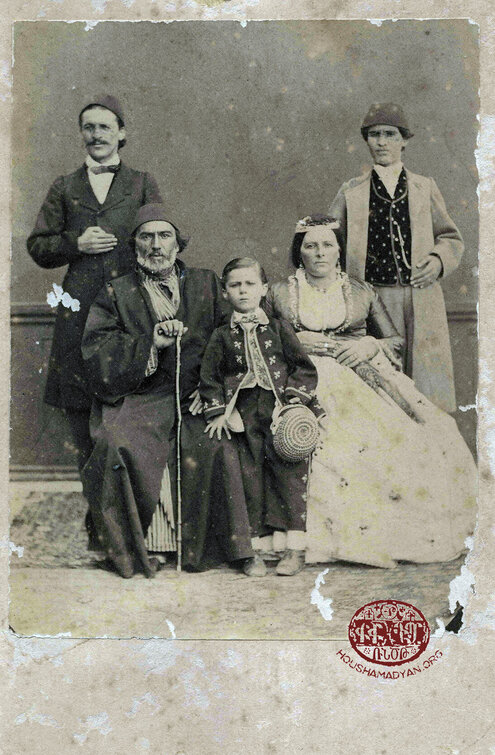
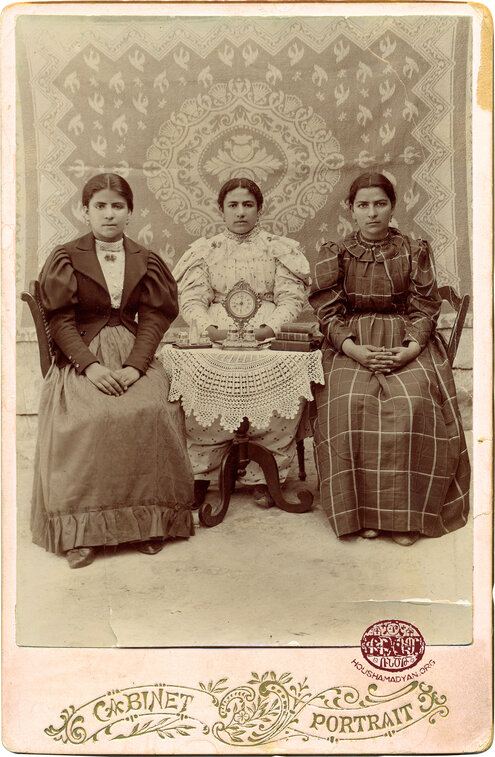
In the late 19th century and early 20th century, the Kradjian brothers were engaged in the manufacturing and sale of Ayntab embroidery. One of the brothers, Avedis, visited France in 1907, with the aim of expanding the family business. Nazar Kradjian, with the help of his brothers and sister, Khanoum Leylegian, established a trading house in London to export Ayntab embroidery. [42]
Garoudj Karamanougian (Djivan Garoudj), thanks solely to his own hard work and efforts, became one of the Ayntab’s most prominent merchants and landowners. Karamanougian’s wealth reached 45,000 Ottoman pounds, of which 15,000 was invested in real estate (shops in the city and fields, orchards, and nut farms in the countryside) that secured him large profits. He had invested another 15,000 pounds in the field of embroidery. A total of 4,000 to 5,000 Ayntab women produced embroidery (of the Ayntab nakhsh type) for his business. The product was exported to the United States of America. To ensure a secure foothold in the American market, Karamanougian had sent his son, Movses Karamanougian, to America. The final third of Karamanougian’s wealth, another 15,000 pounds, was invested in the large manufacturers’ market located on Sobourdji Road. [43]

Jewelry
Jewelry began growing in Ayntab between 1750 and 1800. It was one of the trades practiced exclusively by Armenians. The products of Ayntab jewelers were so refined and elegant that they could truly be considered works of art. As of the early 19th century, the city’s jewelers still mostly crafted ornaments, eucharistic objects, censers, communion chalices, lamps, bells, flabella, candelabras, crosses, gold ornaments for Bibles and hymnals, etc. Beginning in the 1850s, dining utensils and women’s trinkets and adornments began rising in popularity, and these were often carved and engraved. In the early years of the industry, Ayntab jewelers were only able to meet the demand of the local market and that of nearby villages. Until 1900, raw gold was obtained locally, by melting old coins or old gold items. But soon, jewelers began importing the ore from Europe and America. [44]
The best examples of Ayntab jewelry were the rings, bracelets, earrings, fine watch chains, crosses, and other items crafted by the city’s Armenian master jewelers. Particularly well-known were the gem-mounted rings called antika. The gems were mined from the hill called Keber, southeast of Ayntab, and had a translucent red or dark red color. The rings were called antika because many were engraved with figures of Roman soldiers, women, or other figures. Such rings were in very high demand among the wealthy residents of Ayntab. [45]
In 1915, Ayntab was home to more than 50 jewelry shops owned by Armenians, each employing three to five workers. Among the most well-known were the Nazarian, Daghlian, Davoyan, and Pandjardjian jewelry houses. The well-known master jewelers from these families included Garabed Daghlian and his sons, Kevork and Krikor; Tavit Davoyan; Roupen Davoyan, and others. They were not only skilled jewelers, but also stalwart supporters of community projects and initiatives. The celebrated Nazaretian clan of Ayntab was also involved in jewelry. [46] Nazar Agha Nazaretian (1815-1887) was a skilled jeweler and a famed merchant. At the same time, he served as the Persian consul in Ayntab. In the city, he was better known by the name of Kara Nazar (“Black” Nazar). The city’s Nazar Agha Grand Khan, built by his son, Nigoghos Agha Nazaretian, was named after him. [47]
As we have already noted, the Nazarian family was among the Ayntab families with a history of involvement in jewelry. Haroutyun Nazarian, son of jeweler Garabed Nazarian, was not only a highly skilled craftsman, but was also well-known for his philanthropy. He regularly supported cultural events, and he sat on the board of trustees of the Vartanian and Hayganoushian schools. For his philanthropic activities, he received several edicts of appreciation from Sahag II, Catholicos of the Holy See of Cilicia from 1902 to 1939. [48]
The Kalemkyarian family also made important contributions to the field of jewelry in Ayntab. Kalemkyar Garabed; his famous son, Melkon Kalemkyarian; and the latter’s sons crafted ecclesiastical items and other utensils, decorated with their unique engravings and carvings. [49]

Copper Smithing
Copper smithing was another one of the city’s ancient trades. It included two branches – first, there were craftsmen responsible for melting, purifying, and smelting copper. Prominent among these were Sarkis and Hovhannes Yaghlian, two brothers who were natives of Marash. A second group of coppersmiths made copper sheets from raw copper and crafted various items with these sheets.
The coppersmiths of the city were exclusively Armenian. The items they crafted were of such high quality that they could be considered works of art. Both the copper and silver wares of Ayntab could easily compete with European imports. Copper smithing experienced a period of significant growth in the 1840s-1850s, with smiths beginning to produce more kitchen and household items, such as distillers, various types of braziers/heaters, samovars, etc. In the 1880s, the coppersmiths of Ayntab began exporting their wares. The main export markets were Adana, Zeytoun, Malatia, Siverek, Ourfa, Antioch, Aleppo, and Damascus. Ayntab was home to more than 60 copper smithing workshops, each employing four to ten workers. The profession secured a middle-class life for its practitioners, though some coppersmiths also became wealthy. In 1910, to meet the local demand for copper products, Mgrdich Demirdjian imported machinery that helped process copper. [50]
In the early 19th century, Kalaydju Garabed Khalfe introduced into Ayntab the craft of engraving and sculpting metal items – the craft of the kalemkyar (engraver). He was extremely successful, and thereafter changed his surname from Kalaydju to Kalemkyarian [51] (kalemkyar is Turkish for a craftsman who works with a ghalam/kalem (an engraving pen) [52]). Melkon Ousda transformed the family craft into an art, signing his works with a stamp that read “Melkon Kalemkyarian and Sons.” Melkon was also an expert joiner, and had an understanding of architecture and machinery. Melkon’s son, Haroutyun Kalemkyarian, exhibited great talents in drawing from a young age, and began working for the family business at the age of 11. [53]
The Kalemkyarians not only continuously refined their products from the artistic perspective, but they also strove to make them more practical and convenient. Melkon Kalemkyarian invented an improved version of a distilling pot with circular piping, which more accurately measured the temperature of the mixture being distilled. [54] As his contemporaries noted, Master Melkon, before starting any task, would first take the time to properly prepare and arrange all the necessary tools, anvils, and hammers. He was so particular that sometimes, the preparations lasted longer than the actual task. [55]
One of Melkon Kalemkyarian’s well-known works was the sconce of the Holy Virgin Church, which he donated to the church in 1897. It was beautifully and skillfully carved, and had 12 branches, which bore the lanterns. Under each branch was the carving of an angel looking downward, with its wings spread wide. Another example of his work was an exceptionally beautiful brazier that he made sometime before the 1915 deportations. [56]
The sconces, chalices, flabella, censers, vessels, and trays produced by the Kalemkyarians were considered objects of beauty and marks of opulence in various parts of the world. Many prominent and wealthy individuals owned braziers, kettles, basins, and silver and gilded trays and utensils crafted by the family. [57]
The Kalemkyarian family’s involvement in copper smithing spanned about 200 years. The family practiced the trade in three different cities over that period. In Ayntab, their store/workshop was located at the entrance of the jewelers’ market. In this ancient, arched market, Master Melkon’s neighbor was the jeweler Krikor Daghulian, while the second floor of the same building housed a Turkish school. After the massacres and deportations of 1915, the Kalemkyarian family settled down and re-established their business in Damascus, in the Hamidiye Market. After the Armistice, the family returned to Ayntab, but some time later, they were once again forcibly deported, and left Ayntab for good. They again settled down in Damascus, but moved to Aleppo in 1924. They opened a workshop on Khandag Street, which operated until 1961. [58] No coppersmith in Ayntab, or even outside of Ayntab, could compete with the Kalemkyarians.
The sons of Arslan Garabed, of the Arslanian family, were also prominent coppersmiths and silversmiths in Ayntab. They also engraved and carved their products. Most prominent among them were the “Boys of Babashah,” namely Nerses, Adour, and Hovhannes. They produced kitchen wares, decorative vessels, lamps, gold ornaments for copies of the Bible, etc. [59] According to Kevork H. Barsoumian, four generations of this family were involved in the copper smithing trade, including Aslan Baba, Karnu Beoyuk (“Big” Beoyuk), Baba Shah, and Jhoud Aslan.
Other families well-known for their involvement in this field were the Knadjian, Arudjian, Srabionian, Maghakian, Manougian (Gyavour Manoug), and Patanian families. Knadjian, Arslanian Baba, and Karnu Beoyuk were coppersmiths and traders. Among the best master smiths of the city were Master Barbara Garoudj (Garabed), Srabion Srabionian, Nerses Manougian, Kevork Patanian, and others. [60] Nerses and Kevork Guleserian, the brothers of Papken I, Catholicos Coadjutor of the Holy See of Cilicia from 1928 to 1936, were also coppersmiths/tinners. [61] The copperware produced by the Knadjian family was in high demand from Adana to Malatia, and from Ourfa to Damascus. [62]
In his list of coppersmiths active between 1815 and 1915, Berdj Garabedian mentions the following master coppersmiths from Ayntab, whose names he gleaned from the stamps/inscriptions on their products: Hagop Ousda, Minadji Mahdesi Hagop and sons, another Hagop, Artn, Hns. Boshgedzenian [Boshgezenian], Arslan Baba and sons, Arslanian brothers, Krikor Boshgezenian, Yeghia Yesayan, Karayan’s son Ibrahim, Melkon Kalemkyarian, Hagop Kunadjian, Haroutyun Berberian, Nerses Manougian, Nerses Chorbadjian, and Sarkis Chemberdjian. [63]

Ironsmithing/Blacksmithing
Iron smithing/blacksmithing was a popular occupation with ancient roots. Master smiths crafted the tools used by farmers, masons, joiners, horseshoers, and many other craftsmen. Their products not only satisfied the demands of the city and nearby villages, but were also exported.
Until the 1870s, raw metal ore was brought in from the mines of Zeytoun or obtained by recycling old and rusted metal items. In the 1880s, ore began to be important from a larger variety of sources. There were more than 50 smiths’ workshops in the city, each employing four to five workers. [64]
Among the city’s well-known iron smithing families were the Nasanians, Parseghians, Zeytounlians, and various families bearing the name Demirdjian (in Turkish, a demirdji is an ironsmith/blacksmith). A smith named “Brousa Demirdjisi” is also mentioned in sources. Celebrated Ayntab blacksmiths included Hagop Chatmadjian and his son, Kevork; and Nazar Geoyshenian and his sons, Mikayel and Kevork. Another master blacksmith was Frank (Catholic) Garabed ousda and his son, Hadji Haroutyun. The latter had been able to fabricate a Martin rifle, which was produced by the Ottoman government at the time. Prior to the appearance of European-made nails in Ayntab, some of the city’s smiths exclusively manufactured nails. These smiths usually bore the surname Mukhdjian. [65]

Smelting
Smelting was introduced into Ayntab as an occupation in the 1800s. A smelter would create a mold, smelt the metal in the mold’s shape, and polish it. Smelters produced gun parts, silkworm cocoons, bells, inkstands, spoons/small ladles, cast-metal parts of copper plates, water pumps, etc. The product was exported to Syria, Sudan, and Egypt. The raw materials, such as zinc, tin, and lead were imported from Aleppo, while copper was obtained by melting and refining old and broken plates. In 1915, 22 smelting shops operated in Ayntab, each employing three to four workers. Prominent among these were the Ishkhanian, Bandzalian, Isgenian, Hamasian, and Boshgezenian workshops. [66]
One notable member of the Boshgezenian family was gunmaker Hagopdjan, who was also an engraver of metal and brass. Guns bearing his signature stamp are still sought-after today. His son, Krikor Boshgezenian, began making water pumps, using only locally available raw materials, which was considered a great achievement for the time. Krikor’s son-in-law, Haroutyun Barsoumian; and his adopted son, Manuel Baghdasarian, followed in Krikor’s footsteps and continued his work. [67] Haroutyun Barsoumian was the father of Kevork Barsoumian, the intellectual. In his early years, Kevork also practiced smelting. [68]

Weapon Smithing
Weapon smithing, as a craft, was introduced into Ayntab in the early 18th century, and it was passed down from one generation to the next within specific families. About 25 smiths in Ayntab were engaged in this trade, each employing three to four workers. Their merchandise was sold locally and exported abroad by traders. Among the well-known weapon traders were the Boshgezenian, Maksoudian, and Kurumlian companies. The well-known master weaponsmiths in Ayntab between 1860 and 1915 included Mahdesi Yeghia Boshgezenian and Nazar Boshgezenian. [69]

Blade Smithing
Blade smithing was an ancient craft, and included the crafting of blades, barber’s razors, swords, knives, etc. From ancient times, much of the weaponry crafted in Ayntab was exported, particularly to Syria.
There were more than 30 blade smithing workshops in Ayntab, which could mostly be divided into two categories – knife-makers and dagger-makers (puchatchus and kamachus). Each workshop employed five to six workers. The workers earned average, and sometimes below-average wages. Well-known blade-smithing families included many that bore the Bchakdjian and Kamadjian surnames. Other well-known bladesmiths included the Geoyoghlouyan brothers, who also sold their product in other nearby cities. They later became metal traders. [70]

Horseshoeing
Horseshoeing was an ancient craft. Notably, horseshoers in Ayntab also served as veterinarians. In 1915, there were a total of 33 horseshoeing workshops in Ayntab, and almost all the owners enjoyed prosperous lives. Among the city’s well-known horseshoers were Iligian, Solakian, Karoghlanian, Hindoyan, Ipegian, and many Nalbandians (nalband is Turkish for horseshoer), for whom horseshoeing was a family occupation, passed down from one generation to the next. [71]

Saddlery and Packsaddle Making
These crafts were exclusively practiced by Armenians. They were relatively popular occupations, with about 30 shops in the city, each employing two to three workers. Among well-known local saddlers were various families that bore the surname Semerdjian (semerdji is Turkish for saddler) or Chouldjian (chouldji is Turkish for packsaddle maker). [72]

Carpentry/Joinery and Furniture Making
Joinery was one of the ancient trades practiced in Ayntab. Furniture making was introduced into the city at a later time. The city’s joiners and furniture makers could only satisfy local demand, and their wages were average. Among the city’s joiners, some of the best-known families included the Nakashian, Kaymakamian, Krikorian, and Fustukdjian families, as well as many families with the surname Nadjarian, including Nadjar Kasbar. Sources mention the Keshisian workshop among local furniture manufacturers. [73] Haroutyun Kandaharian was engaged in carpentry and the sale of timber in the city. [74]

Masonry
About 300 families in Ayntab were involved in masonry and the related crafts (stonecutters, pavers, plasterers, etc.). Among the local master masons were Kevork Kadehdjian and Vartan Vartanian. Skilled masons and stonecutters also included members of the Zanazanian, Tumtumian, Keomurdjian, and Ousda Kouramian families. [75]

Pottery
Pottery was one of the oldest crafts practiced in Ayntab and enjoyed a period of growth in the late 19th century. Local potters produced not only clay pots and household goods of various kinds, but also the red shingles used for the roofs of local homes. Customarily, the people of Ayntab preserved food for the winter in glazed clay pots. The craft of producing these glazed pots was practiced exclusively by Armenians, and many of these potters bore the surname Bardakdjian (bardakdji is Turkish for potter). A well-known local potter was Hadji Garabed Agha Bardakdjian, a native of Arapgir. [76]

Barbers
This was another common occupation practiced in Ayntab. The city was home to both Armenian and Turkish master barbers, of about equal numbers. [77]

Soapmaking
Soapmaking was an important industry in Ayntab. The city produced high-quality soap, mostly from olive oil. The olives used to make the oil were imported from Kilis. A large number of Armenian workers were employed by the city’s soap factories. [78]
At the end of the 19th century, five soap factories operated in Ayntab. [79] An issue of the Puragn weekly newspaper names these five masnabas, each of which, on average, produced 100 vats of soap per year, with each vat weighing 3,900-4,000 okhas (approximately 5,000-5,130 kilograms or 11,000-11,300 pounds). [80]
In a subsequent issue of Puragn, Nazaret Manoushagian, in an article on soapmaking in Ayntab, lists seven companies involved in the industry. The same article states that soap production for the year had been average, and that a total of 140 ghazans (vat) of soap were produced by the following soap makers:
- - 49 ghazans by Chitdji zade Abdullah Effendi and Co., in the nearby town of Nizib.
- - 23 ghazans by Ardahses Effendi Adanalian.
- - 21 ghazans by Mufti zade Mehmed Khayri Effendi.
- - 21 ghazans by Seoylemegh zade Abdulkader Effendi.
- - 16 ghazans by Mouzaffer zade Hafuz Effendi.
- - 7 ghazans by H. and G. Effendi Nazaretian.
- - 3 ghazans by Effendi Kurkdjian.
Oil producers would supply oil to the soap factories in the months of December and January without haggling over the price in advance. The price of the oil, customarily, would be determined in the months of May and June. The value of the 140 ghazans listed above totaled 21,000 Ottoman pounds. Soap made in Ayntab was consumed both locally and in external markets. [81] Approximately 600,000 okhas of soap were exported from Ayntab every year. [82]
One of the soap factories of Ayntab belonged to Nazar Agha Nazaretian’s youngest son, Garabed Bey Nazaretian. The latter, after his father’s death, inherited the title of consul of Persia in Ayntab. He was also a well-known merchant and often participated in community initiatives, both by donating funds and dedicating his time to them. [83] Other merchants well-known for their involvement in the manufacturing and trade of soaps included Hanne Kurkdjian and Ardashes Adanalian. [84]

Bakeries and Confectioners
Most of the bakers of Ayntab were Armenian. There were 36 bakeries in the city, each employing at least six workers. The bakers of the city lived comfortable lives, and included the Kuledjian, Isbirian, Bosdanian, Ohanian, Chamichian, and Parmaksuzian families, as well as many families with the surname Ekmekdjian (ekmekdji is Turkish for baker). The city’s confectioners were also mostly Armenian, with some exceptions. There were 14 confectioners in the city, each employing at least two workers. Confectioners and cake makers earned a good living. The more notable among them were Kaparigian, Ouzkoushian, Seraydarian, and several families with the surname Keahkedjian. [85]
One of the families well-known for its bakers and confectioners was the Berghoudian family. The Berghoudians were one of the oldest clans of Ayntab. They are mentioned in the 1820s baptism registry of the Holy Virgin Church of the city under the name Perghoudian. Garabed Berghoudian was the son of a fruit seller. Beginning at the age of 12, he worked with his father while also attending night school to complete his interrupted education. At the age of 18, with his brother, Garabed founded his own bakery, which quickly earned a good reputation and soon grew into a trading house. Soon, the Berghoudian Trading House had a preeminent position in the market. The ovens sold by Garabed and Avedis Berghoudian were specially made for baking lahmadjoun and the oily cakes of Ayntab. The brothers continued operating their business in Ayntab until 1922, then in Aleppo until 1933, after which they moved to Beirut. [86]

Photography
The art of photography made its appearance in Ayntab in 1884 thanks to Hovhannes Haladjian. He had learned the profession in 1883-1884 in Constantinople from a famous French master. Returning to his hometown, Haladjian began practicing photography. He was, for an entire decade, the only photographer in the city. [87] Between the years 1884 and 1921, more than two dozen Armenian photographers were active in the city of Ayntab (see Ayntab – Photographers).

- [1] Puragn Weekly, Constantinople, 24 February 1907, number 17-18, p. 101.
- [2] Krikor Koudoulian, Giligyan Ashkharhakroutyun Badgerazart yev Kardisavor [Cilician Geography – with Illustrations and Maps], Constantinople, B. Balukdjian Press, 1922, p. 60.
- [3] Levon Chormisian, Hamabadger Arevmdahayots Meg Tarou Badmoutyan [Overview of a Century of Western Armenian History], volume A (1850-1878), Beirut, Sevan Press, 1972, p. 171.
- [4] Puragn, 24 February 1907, number 17-18, p. 101.
- [5] Father Soukias Eprigian, Badgerazart Pnashkharhig Pararan [Illustrated Dictionary of the Natural World], volume 1, Saint Lazarus Island, Venice, 1903, p. 145.
- [6] Naoum Dasho, “Architectural Innovations in Ayntab,” Puragn, 28 July 1908, number 27, p. 858.
- [7] H. Y. Boghosian, “Notes on Ayntab,” Hay Ayntab [Armenian Ayntab], Beirut, 1963, number 2 (10), p. 41.
- [8] Naoum Dasho, “Architectural Innovations in Ayntab,” p. 858.
- [9] Kevork H. Barsoumian, “The Trades of Ayntab,” Badmoutyun Ayntabi Hayots [History of Ayntab Armenians] (hereafter referred to as BAH), volume B, compiled and edited by Kevork A. Sarafian, Los Angeles, California, 1953, pp. 283-284.
- [10] Ibid., p. 284.
- [11] Krikor Bogharian, Ayntabagank, volume B, p. 698. After the death of Deacon Hovsep Ashdjian, a native of Ayntab and a member of the monastic order of Jerusalem, his estate, thanks to the efforts of Nigoghos Agha Nazaretian, was endowed to fund the construction of Millet Khan (National Home) in 1868. The establishment was registered with the authorities as Azizie Khan (named after the reigning Sultan Abdul-Aziz, on Nighoghos Nazaretian’s suggestion). Millet Khan was the most profitable Armenian establishment in the city. Until 1915, its proceeds funded the Nersesian, Hayganoushian, and Haygazian parochial schools (Krikor Bogharian, “Educational Life in Ayntab and the History of Armenian Schools of Ayntab,” BAH, volume A, compiled and edited by Kevork A. Sarafian, Los Angeles, California, 1953, pp. 653-654.
- [12] Kevork Barsoumian, “The Trades of Ayntab,” BAH, volume B, p. 283.
- [13] Vart, “Ayntab City,” Arax, Saint Petersburg, May 1888, book B, p. 58.
- [14] Kevork Barsoumian, “The Trades of Ayntab,” BAH, volume B, p. 288.
- [15] Ibid., p. 285.
- [16] Krikor Bogharian, “Garabed Karghayan (1878-1945),” Hay Ayntab, Beirut, 1965, number 2, p. 48.
- [17] Krikor Bogharian, Ayntabagank, volume B, Atlas Press, Beirut, 1964, p. 590.
- [18] Kevork Barsoumian, “The Trades of Ayntab,” BAH, volume B, pp. 286-287.
- [19] “Kevork Kouzougian,” BAH, volume B, p. 773.
- [20] Kevork Barsoumian, “The Trades of Ayntab,” BAH, volume B, p. 285.
- [21] Hagop K. Kabbendjian, “Manisa Manufacturing in Ayntab,” BAH, volume B, pp. 301-302.
- [22] Ibid., pp. 294, 301.
- [23] Levon Chormisian, Hamabadger Arevmdahayots Meg Tarou Badmoutyan, p. 170.
- [24] Hagop K. Kabbendjian, “Manisa Manufacturing in Ayntab,” BAH, volume B, pp. 301-302.
- [25] Avedik Guleserian was the father of Papken I (1868-1936), Catholicos Coadjutor of the Holy See of Cilicia (Krikor Bogharian, Ayntabagank, volume B, p. 147).
- [26] Ibid., p. 147.
- [27] Kevork Barsoumian, “The Trades of Ayntab,” BAH, volume B, p. 285.
- [28] Ibid.
- [29] Krikor Bogharian, Ayntabagank, Volume B, p. 625.
- [30] Kevork Barsoumian, “The Trades of Ayntab,” BAH, volume B, p. 288.
- [31] Hraztan Tokmakdjian, Ayntabi Aseghnakordzoutyun [Ayntab Embroidery], volume A, Aleppo and Yerevan, 2015, pp. 89-93.
- [32] Ibid., p. 93.
- [33] Ibid.
- [34] Ibid., pp. 93-95.
- [35] Hovagim H. Bakkalian, “The Embroidery of Ayntab,” BAH, volume B, p. 306.
- [36] Ibid.
- [37] Eliza A. Sachaklian, “Embroidery in Ayntab,” Hay Ayntab, Beirut, 1966, number 2 (22), pp. 29-30.
- [38] Hovagim H. Bakkalian, “The Embroidery of Ayntab,” BAH, volume B, p. 308.
- [39] Krikor Bogharian, “Hovagim Bakkalian (1879-1961), Hay Ayntab, 1962, number 7, p. 35.
- [40] Hovagim H. Bakkalian, “The Embroidery of Ayntab,” BAH, volume B, pp. 308-310.
- [41] Naoum Dasho, “Architectural Innovations in Ayntab,” Puragn, 28 July 1908, number 27, p. 859.
- [42] Krikor Bogharian, Ayntabagank, volume B, p. 116.
- [43] Hagop Kabbendjian, “Garoudj Karamanougian, 1846-1916,” BAH, volume B, pp. 769-770.
- [44] Kevork H. Barsoumian, “The Trades of Ayntab,” BAH, volume B, pp. 276-277.
- [45] Nerses, “Jewelry and Copper smithing in Ayntab,” Hay Ayntab, 1964, number 2 (16), pp. 36-37.
- [46] Kevork H. Barsoumian, “The Trades of Ayntab,” BAH, volume B, p. 277.
- [47] “Nigoghos Agha Nazaretian (1843-1899),” Hay Ayntab, 1964, number 4 (16), p. 10. Also see Badmoutyun Ayntabi Hayots, volume B, p. 751.
- [48] Badmoutyun Ayntabi Hayots, volume B, p. 769.
- [49] Kevork H. Barsoumian, “The Trades of Ayntab,” BAH, volume B, p. 277.
- [50] Ibid., pp. 277-278, 281.
- [51] Vahe N. Guleserian, “The Kalemkyarians, Masters of Fine Art,” Hay Ayntab, 1962, number 6, p. 18.
- [52] Hraztan Tokmakdjian, Kalemkyarianner: Ayntab, Damascus, Haleb [The Kalemkyarians: Ayntab, Damascus, Aleppo], Aleppo, 2016, p. 20.
- [53] Vahe N. Guleserian, “The Kalemkyarians, Masters of Fine Art,” Hay Ayntab, pp. 20-21.
- [54] Kevork H. Barsoumian, “The Trades of Ayntab,” BAH, volume B, p. 280.
- [55] Hraztan Tokmakdjian, Kalemkyarianner: Ayntab, Damascus, Haleb, p. 28.
- [56] Ibid., pp. 32-33.
- [57] Krikor Bogharian, Ayntabagank, volume B, pp. 107-109.
- [58] Hraztan Tokmakdjian, Kalemkyarianner: Ayntab, Damascus, Haleb, p. 16.
- [59] Krikor Bogharian, “Nerses Arslanian (1880-1950),” Hay Ayntab, 1965, number 2 (18), p. 49.
- [60] Kevork H. Barsoumian, “The Trades of Ayntab,” BAH, volume B, pp. 277-278.
- [61] Krikor Bogharian, Ayntabagank, volume B, p. 147.
- [62] Ibid., p. 296.
- [63] Berdj M. Garabedian, “Armenian Copper, 1600-1915,” Haygazian Review of Armenian Studies, volume 6, Beirut, 1977, pp. 208-227.
- [64] Kevork H. Barsoumian, “The Trades of Ayntab,” BAH, volume B, pp. 281-282.
- [65] Ibid., pp. 281-282.
- [66] Ibid., p. 276.
- [67] Ibid.
- [68] Krikor Bogharian, Ayntabagank, volume B, p. 190.
- [69] Kevork H. Barsoumian, “The Trades of Ayntab,” BAH, volume B, pp. 282-283.
- [70] Ibid., p. 284.
- [71] Ibid., pp. 287-288.
- [72] Ibid., p. 290.
- [73] Ibid., pp. 288-289.
- [74] Krikor Bogharian, Ayntabagank, volume B, p. 176.
- [75] Kevork H. Barsoumian, “The Trades of Ayntab,” BAH, volume B, pp. 289.
- [76] Ibid., pp. 290-291.
- [77] Ibid., p. 291.
- [78] Ibid., p. 292.
- [79] Giligia, Ports Ashkharhakroutyan Arti Giligio [Cilicia, An Attempt at the Geography of Modern Cilicia], St. Petersburg, I. Lieberman Press, 1894, p. 356.
- [80] Naoum Dasho, “Architectural Innovations in Ayntab,” p. 859.
- [81] N.[azaret] Manoushagian, “The Soaps of Ayntab,” Puragn, number 29, 12 July 1908, p. 923.
- [82] Kr. H. Kalousdian, Marash gam Kermanig yev Heros Zeytoun [Marash or Kermanig and Heroic Zeytoun], New York, Gochnag [Clarion], 1934, p. 501.
- [83] Badmoutyun Ayntabi Hayots, volume B, p. 756.
- [84] Kevork H. Barsoumian, “The Trades of Ayntab,” BAH, volume B, p. 292.
- [85] Ibid., pp. 289-290.
- [86] Krikor Bogharian, Ayntabagank, volume B, pp. 312-314.
- [87] Rev. S. Haladjian, “The Art of Photography in Ayntab,” BAH, volume B, pp. 292-293.

